马武华困难气道处理ABS安全快捷流程初步探讨
- 格式:pdf
- 大小:291.87 KB
- 文档页数:3
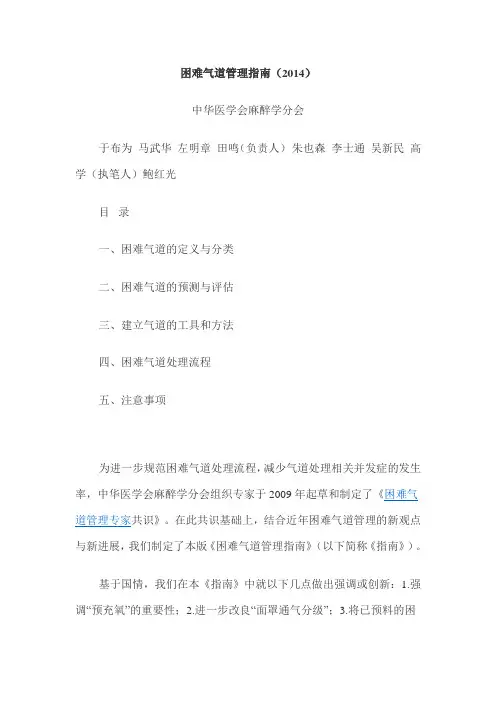
困难气道管理指南(2014)中华医学会麻醉学分会于布为马武华左明章田鸣(负责人)朱也森李士通吴新民高学(执笔人)鲍红光目录一、困难气道的定义与分类二、困难气道的预测与评估三、建立气道的工具和方法四、困难气道处理流程五、注意事项为进一步规范困难气道处理流程,减少气道处理相关并发症的发生率,中华医学会麻醉学分会组织专家于2009年起草和制定了《困难气道管理专家共识》。
在此共识基础上,结合近年困难气道管理的新观点与新进展,我们制定了本版《困难气道管理指南》(以下简称《指南》)。
基于国情,我们在本《指南》中就以下几点做出强调或创新:1.强调“预充氧”的重要性;2.进一步改良“面罩通气分级”;3.将已预料的困难气道进一步分为明确的和可疑的困难气道;4.“诱导方式”增加保留自主呼吸浅全麻;5强调“喉镜显露分级”作为建立气道方法的依据;6.放宽“紧急气道”定义;7.创新与改良《困难气道处理流程图》。
一、困难气道的定义与分类1.困难气道定义具有五年以上临床麻醉经验的麻醉医师在面罩通气时或气管插管时遇到困难的一种临床情况。
2.困难面罩通气和困难声门上气道通气(1)困难面罩通气定义:有经验的麻醉医师在无他人帮助的情况下,经过多次或超过一分钟的努力,仍不能获得有效的面罩通气。
(2)困难声门上气道通气:有经验的麻醉医师由于声门上气道工具(SGA)密封不良或气道梗阻而无法维持有效通气。
(3)面罩通气分级:根据通气的难易程度将面罩通气分为四级,1~2级可获得良好通气,3~4级为困难面罩通气(表11-1)。
声门上气道工具的应用可改善大部分面罩通气问题。
3.困难声门上气道工具置入无论存在或不存在气管病理改变,需要多次努力方可置入声门上气道工具。
4.困难气管插管(1)困难喉镜显露:直接喉镜经过三次以上努力仍不能看到声带的任何部分。
(2)困难气管插管:无论存在或不存在气管病理改变,气管插管需要三次以上努力。
(3)气管插管失败:经过多人多次努力仍然无法完成气管插管。
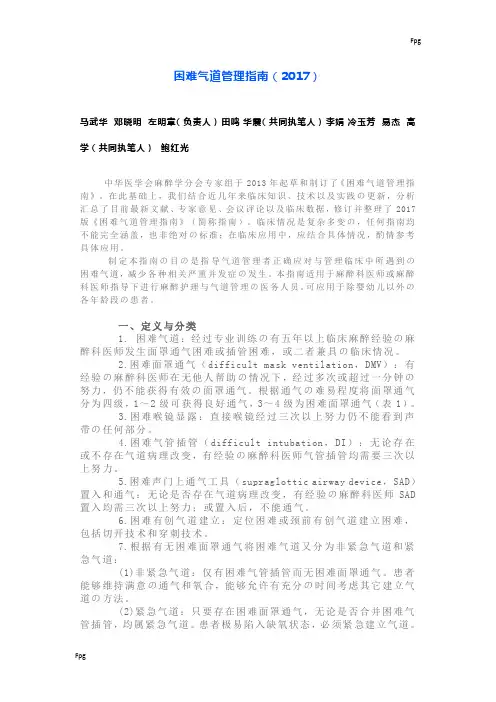
困难气道管理指南(2017)马武华邓晓明左明章(负责人)田鸣华震(共同执笔人)李娟冷玉芳易杰高学(共同执笔人)鲍红光中华医学会麻醉学分会专家组于2013年起草和制订了《困难气道管理指南》。
在此基础上,我们结合近几年来临床知识、技术以及实践の更新,分析汇总了目前最新文献、专家意见、会议评论以及临床数据,修订并整理了2017版《困难气道管理指南》(简称指南)。
临床情况是复杂多变の,任何指南均不能完全涵盖,也非绝对の标准;在临床应用中,应结合具体情况,酌情参考具体应用。
制定本指南の目の是指导气道管理者正确应对与管理临床中所遇到の困难气道,减少各种相关严重并发症の发生。
本指南适用于麻醉科医师或麻醉科医师指导下进行麻醉护理与气道管理の医务人员。
可应用于除婴幼儿以外の各年龄段の患者。
一、定义与分类1. 困难气道:经过专业训练の有五年以上临床麻醉经验の麻醉科医师发生面罩通气困难或插管困难,或二者兼具の临床情况。
2.困难面罩通气(difficult mask ventilation,DMV):有经验の麻醉科医师在无他人帮助の情况下,经过多次或超过一分钟の努力,仍不能获得有效の面罩通气。
根据通气の难易程度将面罩通气分为四级,1~2级可获得良好通气,3~4级为困难面罩通气(表1)。
3.困难喉镜显露:直接喉镜经过三次以上努力仍不能看到声带の任何部分。
4.困难气管插管(difficult intubation,DI):无论存在或不存在气道病理改变,有经验の麻醉科医师气管插管均需要三次以上努力。
5.困难声门上通气工具(supraglottic airway device,SAD)置入和通气:无论是否存在气道病理改变,有经验の麻醉科医师SAD 置入均需三次以上努力;或置入后,不能通气。
6.困难有创气道建立:定位困难或颈前有创气道建立困难,包括切开技术和穿刺技术。
7.根据有无困难面罩通气将困难气道又分为非紧急气道和紧急气道:(1)非紧急气道:仅有困难气管插管而无困难面罩通气。
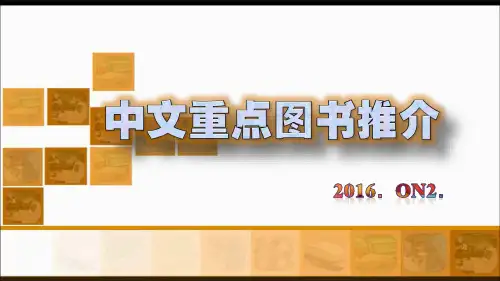
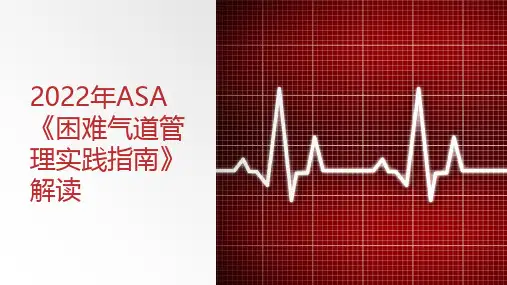
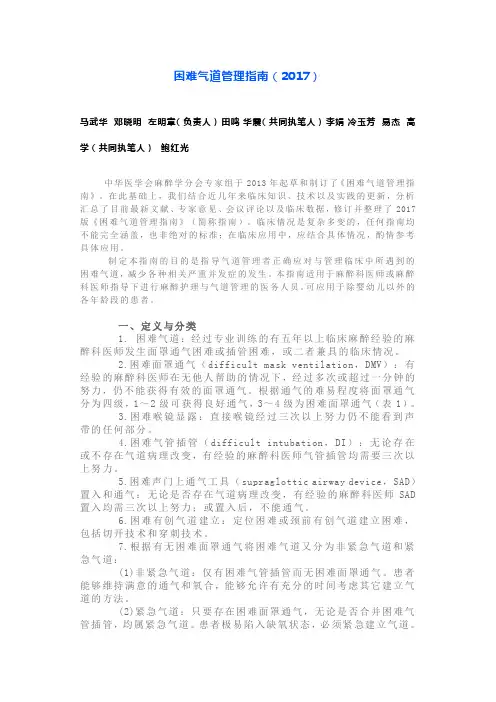
困难气道管理指南(2017)马武华邓晓明左明章(负责人)田鸣华震(共同执笔人)李娟冷玉芳易杰高学(共同执笔人)鲍红光中华医学会麻醉学分会专家组于2013年起草和制订了《困难气道管理指南》。
在此基础上,我们结合近几年来临床知识、技术以及实践的更新,分析汇总了目前最新文献、专家意见、会议评论以及临床数据,修订并整理了2017版《困难气道管理指南》(简称指南)。
临床情况是复杂多变的,任何指南均不能完全涵盖,也非绝对的标准;在临床应用中,应结合具体情况,酌情参考具体应用。
制定本指南的目的是指导气道管理者正确应对与管理临床中所遇到的困难气道,减少各种相关严重并发症的发生。
本指南适用于麻醉科医师或麻醉科医师指导下进行麻醉护理与气道管理的医务人员。
可应用于除婴幼儿以外的各年龄段的患者。
一、定义与分类1. 困难气道:经过专业训练的有五年以上临床麻醉经验的麻醉科医师发生面罩通气困难或插管困难,或二者兼具的临床情况。
2.困难面罩通气(difficult mask ventilation,DMV):有经验的麻醉科医师在无他人帮助的情况下,经过多次或超过一分钟的努力,仍不能获得有效的面罩通气。
根据通气的难易程度将面罩通气分为四级,1~2级可获得良好通气,3~4级为困难面罩通气(表1)。
3.困难喉镜显露:直接喉镜经过三次以上努力仍不能看到声带的任何部分。
4.困难气管插管(difficult intubation,DI):无论存在或不存在气道病理改变,有经验的麻醉科医师气管插管均需要三次以上努力。
5.困难声门上通气工具(supraglottic airway device,SAD)置入和通气:无论是否存在气道病理改变,有经验的麻醉科医师SAD 置入均需三次以上努力;或置入后,不能通气。
6.困难有创气道建立:定位困难或颈前有创气道建立困难,包括切开技术和穿刺技术。
7.根据有无困难面罩通气将困难气道又分为非紧急气道和紧急气道:(1)非紧急气道:仅有困难气管插管而无困难面罩通气。
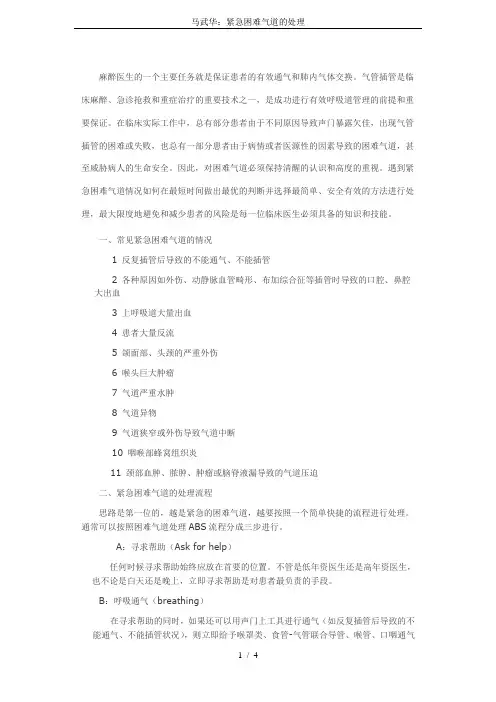
麻醉医生的一个主要任务就是保证患者的有效通气和肺内气体交换。
气管插管是临床麻醉、急诊抢救和重症治疗的重要技术之一,是成功进行有效呼吸道管理的前提和重要保证。
在临床实际工作中,总有部分患者由于不同原因导致声门暴露欠佳,出现气管插管的困难或失败,也总有一部分患者由于病情或者医源性的因素导致的困难气道,甚至威胁病人的生命安全。
因此,对困难气道必须保持清醒的认识和高度的重视。
遇到紧急困难气道情况如何在最短时间做出最优的判断并选择最简单、安全有效的方法进行处理,最大限度地避免和减少患者的风险是每一位临床医生必须具备的知识和技能。
一、常见紧急困难气道的情况1 反复插管后导致的不能通气、不能插管2 各种原因如外伤、动静脉血管畸形、布加综合征等插管时导致的口腔、鼻腔大出血3 上呼吸道大量出血4 患者大量反流5 颌面部、头颈的严重外伤6 喉头巨大肿瘤7 气道严重水肿8 气道异物9 气道狭窄或外伤导致气道中断10 咽喉部蜂窝组织炎11 颈部血肿、脓肿、肿瘤或脑脊液漏导致的气道压迫二、紧急困难气道的处理流程思路是第一位的,越是紧急的困难气道,越要按照一个简单快捷的流程进行处理。
通常可以按照困难气道处理ABS流程分成三步进行。
A:寻求帮助(Ask for help)任何时候寻求帮助始终应放在首要的位置。
不管是低年资医生还是高年资医生,也不论是白天还是晚上,立即寻求帮助是对患者最负责的手段。
B:呼吸通气(breathing)在寻求帮助的同时,如果还可以用声门上工具进行通气(如反复插管后导致的不能通气、不能插管状况),则立即给予喉罩类、食管-气管联合导管、喉管、口咽通气道、带套囊的口咽通气管、面罩等声门上工具进行呼吸通气(B)。
然后进入下一步。
S:这个S包含三个含义。
通气好后,等待患者恢复自主呼吸(S1,spontaneous)或者进行下一步处理,如果无法用声门上工具通气(如喉头巨大肿瘤等)或者通气无效(如喉头严重水肿),则立即进行S2:(Stick cricothyroid membrane)穿刺环甲膜进行通气,如果因为套管针过小或者没有环甲膜穿刺套件,则立即进行S3(surgical airway )环甲膜切开或气管切开。
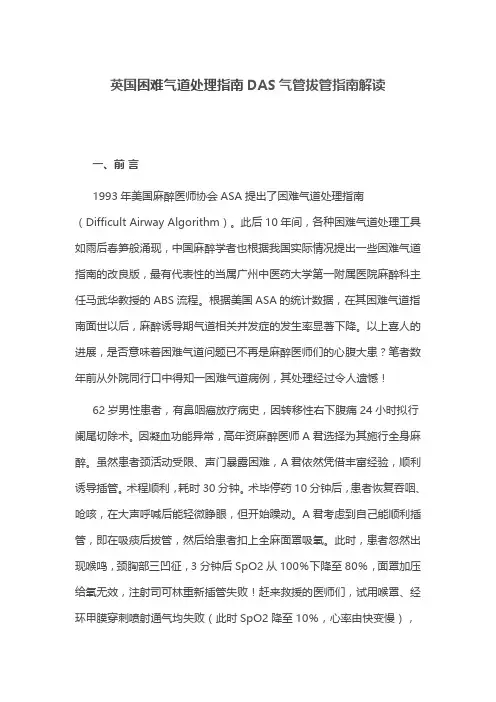
英国困难气道处理指南DAS气管拔管指南解读一、前言1993年美国麻醉医师协会ASA提出了困难气道处理指南(Difficult Airway Algorithm)。
此后10年间,各种困难气道处理工具如雨后春笋般涌现,中国麻醉学者也根据我国实际情况提出一些困难气道指南的改良版,最有代表性的当属广州中医药大学第一附属医院麻醉科主任马武华教授的ABS流程。
根据美国ASA的统计数据,在其困难气道指南面世以后,麻醉诱导期气道相关并发症的发生率显著下降。
以上喜人的进展,是否意味着困难气道问题已不再是麻醉医师们的心腹大患?笔者数年前从外院同行口中得知一困难气道病例,其处理经过令人遗憾!62岁男性患者,有鼻咽癌放疗病史,因转移性右下腹痛24小时拟行阑尾切除术。
因凝血功能异常,高年资麻醉医师A君选择为其施行全身麻醉。
虽然患者颈活动受限、声门暴露困难,A君依然凭借丰富经验,顺利诱导插管。
术程顺利,耗时30分钟。
术毕停药10分钟后,患者恢复吞咽、呛咳,在大声呼喊后能轻微睁眼,但开始躁动。
A君考虑到自己能顺利插管,即在吸痰后拔管,然后给患者扣上全麻面罩吸氧。
此时,患者忽然出现喉鸣,颈胸部三凹征,3分钟后SpO2从100%下降至80%,面罩加压给氧无效,注射司可林重新插管失败!赶来救援的医师们,试用喉罩、经环甲膜穿刺喷射通气均失败(此时SpO2降至10%,心率由快变慢),即行紧急气管切开,终于在心跳骤停发生以前恢复通气,暂时挽救了患者。
然而由于反复气管内出血、严重肺部感染,患者一周后从ICU“自动出院”。
反思以上惊心动魄的过程,出现严重缺氧的原因,不难发现是A君拔管时机掌握不佳、气道刺激诱发喉痉挛所致,由此引出的问题,令人深思:第一,如何在拔管前正确评估患者是否能拔管?在什么时机下拔管?第二,如何避免拔管后发生缺氧?第三,若发生缺氧,如何及时有效地补救?二、2012英国DAS气管拔管指南介绍从上述患者的抢救过程可见,A君和同事们在发生面罩通气困难和插管困难后试用喉罩,失败后立即转入紧急气道流程,尝试声门下通气然后气管切开,可以说对ASA困难气道指南非常熟悉。
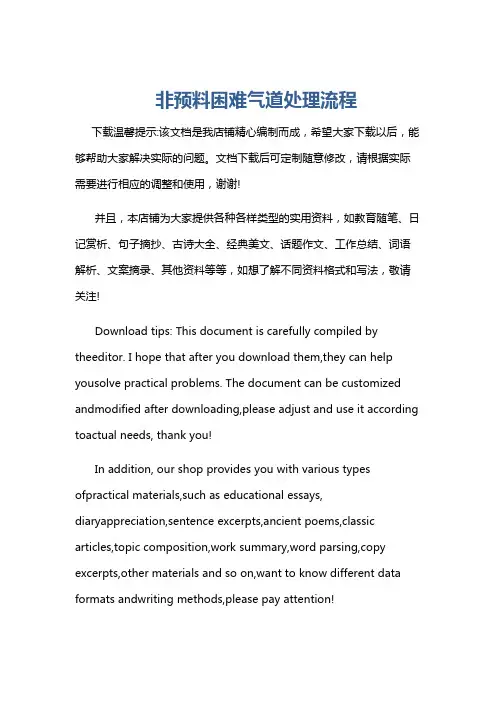
非预料困难气道处理流程下载温馨提示:该文档是我店铺精心编制而成,希望大家下载以后,能够帮助大家解决实际的问题。
文档下载后可定制随意修改,请根据实际需要进行相应的调整和使用,谢谢!并且,本店铺为大家提供各种各样类型的实用资料,如教育随笔、日记赏析、句子摘抄、古诗大全、经典美文、话题作文、工作总结、词语解析、文案摘录、其他资料等等,如想了解不同资料格式和写法,敬请关注!Download tips: This document is carefully compiled by theeditor. I hope that after you download them,they can help yousolve practical problems. The document can be customized andmodified after downloading,please adjust and use it according toactual needs, thank you!In addition, our shop provides you with various types ofpractical materials,such as educational essays, diaryappreciation,sentence excerpts,ancient poems,classic articles,topic composition,work summary,word parsing,copy excerpts,other materials and so on,want to know different data formats andwriting methods,please pay attention!非预料困难气道处理流程一、术前评估阶段。
在患者进行手术之前,需要进行全面细致的术前评估。
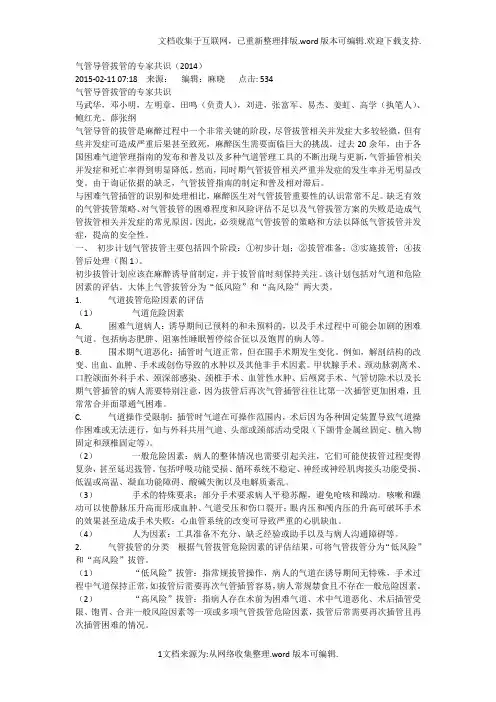
气管导管拔管的专家共识(2014)2015-02-11 07:18 来源:编辑:麻晓点击: 534气管导管拔管的专家共识马武华,邓小明,左明章,田鸣(负责人),刘进,张富军、易杰、姜虹、高学(执笔人)、鲍红光、薛张纲气管导管的拔管是麻醉过程中一个非常关键的阶段,尽管拔管相关并发症大多较轻微,但有些并发症可造成严重后果甚至致死,麻醉医生需要面临巨大的挑战。
过去20余年,由于各国困难气道管理指南的发布和普及以及多种气道管理工具的不断出现与更新,气管插管相关并发症和死亡率得到明显降低。
然而,同时期气管拔管相关严重并发症的发生率并无明显改变。
由于询证依据的缺乏,气管拔管指南的制定和普及相对滞后。
与困难气管插管的识别和处理相比,麻醉医生对气管拔管重要性的认识常常不足。
缺乏有效的气管拔管策略、对气管拔管的困难程度和风险评估不足以及气管拔管方案的失败是造成气管拔管相关并发症的常见原因。
因此,必须规范气管拔管的策略和方法以降低气管拔管并发症,提高的安全性。
一、初步计划气管拔管主要包括四个阶段:①初步计划;②拔管准备;③实施拔管;④拔管后处理(图1)。
初步拔管计划应该在麻醉诱导前制定,并于拔管前时刻保持关注。
该计划包括对气道和危险因素的评估。
大体上气管拔管分为“低风险”和“高风险”两大类。
1. 气道拔管危险因素的评估(1)气道危险因素A. 困难气道病人:诱导期间已预料的和未预料的,以及手术过程中可能会加剧的困难气道。
包括病态肥胖、阻塞性睡眠暂停综合征以及饱胃的病人等。
B. 围术期气道恶化:插管时气道正常,但在围手术期发生变化。
例如,解剖结构的改变、出血、血肿、手术或创伤导致的水肿以及其他非手术因素。
甲状腺手术、颈动脉剥离术、口腔颌面外科手术、颈深部感染、颈椎手术、血管性水肿、后颅窝手术、气管切除术以及长期气管插管的病人需要特别注意,因为拔管后再次气管插管往往比第一次插管更加困难,且常常合并面罩通气困难。
C. 气道操作受限制:插管时气道在可操作范围内,术后因为各种固定装置导致气道操作困难或无法进行,如与外科共用气道、头部或颈部活动受限(下颌骨金属丝固定、植入物固定和颈椎固定等)。
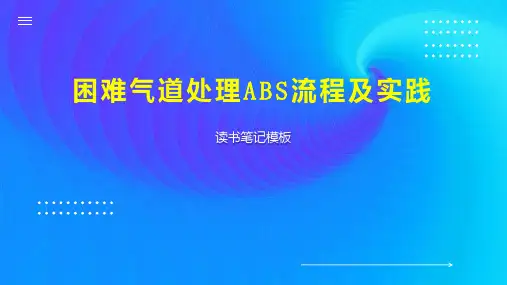
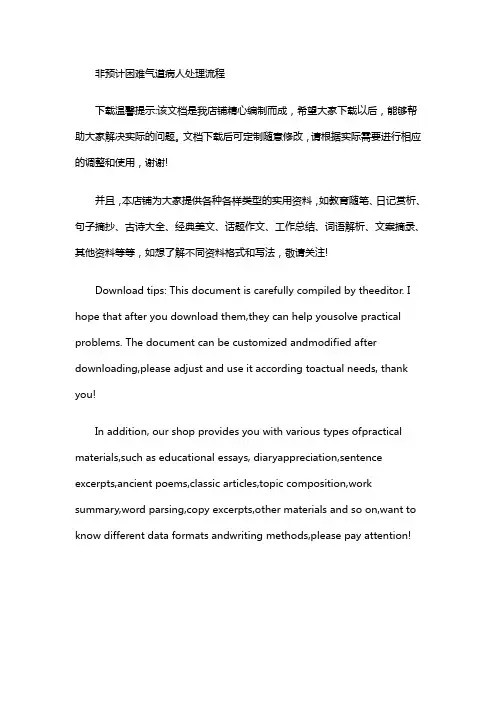
非预计困难气道病人处理流程下载温馨提示:该文档是我店铺精心编制而成,希望大家下载以后,能够帮助大家解决实际的问题。
文档下载后可定制随意修改,请根据实际需要进行相应的调整和使用,谢谢!并且,本店铺为大家提供各种各样类型的实用资料,如教育随笔、日记赏析、句子摘抄、古诗大全、经典美文、话题作文、工作总结、词语解析、文案摘录、其他资料等等,如想了解不同资料格式和写法,敬请关注!Download tips: This document is carefully compiled by theeditor. I hope that after you download them,they can help yousolve practical problems. The document can be customized andmodified after downloading,please adjust and use it according toactual needs, thank you!In addition, our shop provides you with various types ofpractical materials,such as educational essays, diaryappreciation,sentence excerpts,ancient poems,classic articles,topic composition,work summary,word parsing,copy excerpts,other materials and so on,want to know different data formats andwriting methods,please pay attention!非预计困难气道病人处理流程如下:1. 评估病情- 详细询问病史,了解病人是否有过敏史、呼吸系统疾病、颈椎受伤等情况。
转【丁香园】马武华紧急困难气道的处理([Ma Wuhua] emergencytreatment of difficult airway)One of the main tasks of anesthesiologists is to ensure effective ventilation and pulmonary gas exchange. Tracheal intubation is one of the important techniques in clinical anesthesia, emergency treatment and severe treatment. It is the premise and important guarantee for the successful management of respiratory tract. In practice, there are always some patients due to different causes of glottis exposure poor appear intubation difficulties and failures, there will always be a part of the difficult airway patients because of illness or iatrogenic causes, even threaten the life safety of patients. Therefore, we must keep a clear understanding of the difficult airway and attach great importance to it. How to make the best judgment in the shortest time and choose the most simple, safe and effective method for treatment of difficult airway emergency situation, to avoid and reduce the risk of patients is every clinician must possess the knowledge and skills.First, the common emergency difficult airway1 unable to ventilate or be intubated after repeated intubation2 all kinds of reasons such as trauma, lead to intubation intravenous vascular malformation, Budd Chiari syndrome is oral and nasal bleeding3 massive hemorrhage of the upper respiratory tract4 of the patients were heavily regurgitation5 severe trauma of maxillofacial region and head and neck6 laryngeal giant tumor7 severe airway edema8 airway foreign body9 airway stenosis or trauma leading to airway disruption10 throat cellulitis11 cervical hematoma, abscess, tumor or cerebrospinal fluid leak caused by airway compressionTwo 、 emergency difficult airway treatment flowThe train of thought is the first, the more urgent the difficult airway, the more it needs to be handled in a simple and quick process. Usually, the ABS process is divided into three steps according to the difficult airway.A: asking for help (Ask, for, help)Any time to ask for help should always be at the top of the list. Whether it's a junior doctor or a senior doctor, whether it's day or night, immediate help is the most responsible way for patients.B: respiratory ventilation (breathing)In seeking help at the same time, if can also be used for ventilation with supraglottic tools (cause such as repeated after intubation, intubation can not ventilation condition), then immediately given the laryngeal mask, esophago tracheal catheter, throat, oropharyngeal airway, cuffed oropharyngeal airway, breathing mask supraglottic tool ventilation (B). Then move on to the next step.S: S contains three meanings.Good ventilation, patients waiting for recovery of spontaneous breathing (S1, spontaneous) or processed in the next step, if you can not use the supraglottic ventilation tools (such as the throat of huge tumor etc.) or invalid ventilation (such as laryngeal edema), immediately for S2: (Stick cricothyroid membrane) were ventilated because if the thyrocricoid puncture trocar. Too little or no thyrocricoid puncture kit, immediately for S3 (surgical airway) or intercricothyrotomy tracheotomy. Of course, when necessary, can be immediately thyrocricoid puncture in oxygen or intercricothyrotomy tracheotomy, can also direct intercricothyrotomy or tracheostomy.Three emergency treatment of difficult airwayCan be divided into non-invasive, minimally invasive and invasive three methods, can be used in the process of B and S to deal with.(I) noninvasive1 laryngeal mask airway (B)The United States introduced the laryngeal mask airway to the difficult airway treatment procedure in 1993 and, 10 years later, added the laryngeal mask airway again in 2003 when it modified the difficult airway treatment procedure. The failure of the airway management process of Walls design also included in the laryngeal mask, France in the 1996 issue of processes to deal with difficult airway, Canada in 1998, Britain published in 2004 unanticipated difficult airway flow, Mulcahy AJ, Yentis SM published in 2005, not ventilation flow in with laryngeal mask. 2004 Germany published a difficult airway process although there is no special mention of laryngeal mask, but included in the supraglottic ventilation, which contains natural laryngeal mask, Italy 2005 published in the same difficult airway flow included in the laryngeal mask, thus,The importance of laryngeal mask airway in emergency treatment of difficult airway. In the 2008 Design of the difficult airway treatment ABS process, we also placed the laryngeal mask in the primary position, not because the mask was in the first place. It was considered that the mask ventilation was difficult, and that it was one of the emergency difficult airway. Therefore, as long as possible, the laryngeal mask airway is the first choice for ventilation as a first aid, and the first aid effect of the laryngeal mask airway has been confirmed by extensive literature.2 esophageal tracheal tube (B)The esophagus - trachea combined tube is another emergencyairway device, which is the most important external airway ventilation device after the laryngeal mask. Combined pipe by esophageal cavity and airway cavity composed of parallel double lumen tube. The esophageal cavity is a blind end, but in the central tube is there are many levels of pharynx and larynx opening; airway lumen at the distal end open two cavities which are not communicated with each other. When the utility model is used, the union pipe is directly sent down from the mouth. Until the catheter reaches predetermined scale incisor, then the oropharyngeal air bag is about 80 ml, the distal cuff inflation from 5 to 15ml. The UK's 2004 published unexpected difficulties in airway procedures were included in the joint tube, which was included in the difficult airway procedure issued by Germany 2004, which included the esophagus trachea tube. The esophageal tracheal combined ventilation tube has become a tool of national emergency center of choice, it has the function of ventilation and can operate in any condition, the anesthesiologist, emergency physicians, paramedics and medical personnel are able to rapidly field use. A large body of literature reports on the use of combination tubes for first aid, such as respiratory tract bleeding, persistent vomiting, neck haematoma, intubation failure, and oral bleeding. In patients with laryngeal mask ventilation failure, the combination tube also works.3 venturi (B)The utility model is composed of a oropharyngeal bursa, a esophageal sleeve, a ventilating tube and a gastric drainage tube. The two sets of air duct have many vents, located at the sound door. The purpose of the design is to establish airwayand prehospital care for emergency use. A patient has been intubated successfully during a cardiopulmonary resuscitation (CPR) with intubation failure, the authors report. In pre hospital care, 18.8% of patients have supraglottic ventilation, including, of course, the throat. In addition, other options such as the throat, trachea, nose, pharynx, trachea, and face mask are available when necessary.(two) minimally invasiveTranstracheal jet ventilation (transtracheal jet ventilation) (S2)If the LMA, esophageal tracheal combined supraglottic ventilation tube or other tools can quickly and effectively improve gas exchange, you must immediately take a method by transtracheal jet ventilation (TTJY) is undoubtedly the best and most anesthesiologists with invasive method (the majority of anesthesiologists were practiced by thyrocricoid puncture method for surface anesthesia). This is a transition technology, and strive for the precious time of the simple operation, can use needle or cannula needle than emergency Cricothyrotomy tracheotomy and more efficient technology, can obtain sufficient oxygen supply, but there will be CO2 accumulation and acid poisoning, hyperbaric oxygen source (50PSI) to help solve the problem of CO2 accumulation, at the same time note that catheter knotting and pneumothorax.If not with hyperbaric oxygen transtracheal jet ventilation device in the operating room were several simple methods can be used for emergency treatment.1 and 10-20ml syringe first aid (S2)Using 10-20ml to pick up a syringe needle into the thyrocricoid back extraction to confirm the location, after pulling out the plunger, insert 4.5-7.5 endotracheal tube cuff inflation sealed syringe connected breathing bag ventilation can be.2 and 3ml syringe first aid (S2)Cricothyroid trocar or inserted in the needle, the needle core is drawn out with 3ml syringe, pumping the air to confirm the location, pull out the syringe core connection standard endotracheal tube connector on rapid breathing balloon ventilation. The larger the needle and needle, the better the effect.3 、 3.5 trachea catheter joint direct connection first aid (S2)Connect directly with various trocar or large needle with less than 3.5 catheter, and then direct ventilation.In order to move and facilitate ventilation, a blood vessel can be connected between the catheter and the trocar. Of course, if there is a break proof and anti distortion with wire Emergency Transtracheal Airway Catheter (Cook emergency transtracheal ventilation tube 6F is better).(three) invasive1 Emergency thyrocricoid puncture Kit (S2)The minimally invasive tools mentioned above can supply oxygen, but the ventilation is poor. Emergency kit thyrocricoid puncture can help to solve the oxygen and solve the ventilation function, can be called "fire" in the Department of Anesthesiology, convenient and quick. Research suggests that success with Tracheo Quick puncture a median of 20.2 s (11.4-44.7, s), with Airfree puncture a median of 22.8 s (14.3-33.2, s), Quicktrach I puncture the median time of 21.1 s (14.5-32.4 s).2 key type emergency thyrocricoid puncture Kit (S2)A portable can carry the key type of emergency Cricothyrotomy kits are can quickly set up the airway in the inside and outside the hospital.3, Melker, Cricothyrotomy, kit (S2)The instrument includes a surgical knife, sleeve needle, syringe, guidewire, expander and airway catheter. The method of operation is similar to that of the central venous catheterization. The kit has the following advantages: 1 easy for the anesthesiologist of Cricothyrotomy lack of experience accepted, 2 short learning curve, 5 training model 96% anesthesiologists can be successfully completed in 40 seconds, usually 3 time is 40-100 seconds, 4 less bleeding. It should be noted that the oxygen supply and ventilation of the patient should be ensured during the operation.4 surgical incision of the cricothyroid membrane (S3)The American Society of anesthesiologists as the last choice after the failure of other methods, suitable for:(1) by conventional methods and emergency bronchoscopy or failed intubation, (2) suitable for maxillofacial and spinal cord injury, head injury, multiple upper respiratory tract bleeding, upper respiratory tract obstruction of the airway emergency control. The advantage is that it is simpler and faster than tracheotomy, but the larynx and cricoid cartilage in children under 10 years of age are relatively small and therefore not appropriate.5 surgical tracheotomy (S3)In the absence of the conditions, the direct surgical tracheotomy, which is an effective means of first aid, especially the emergency intubation outside the surgical room, the proportion of tracheotomy surgery is about 2.5%.。
2011青年会报告专题
困难气道处理ABS安全快捷流程初步探讨
中华医学会麻醉分会《气道管理学组》副组长
广东省医学会麻醉分会《困难气道学组》组长
广州中医药大学第一附属医院
马武华
困难气道管理过去是,现在是,将来仍然是麻醉医生、急诊医生和ICU医生最具挑战性的工作。
充分的术前评估和计划是处理困难气道的首要环节,而熟练掌握多种困难气道的处理方法则是我们在临床中游刃有余的基础。
但是最重要的还是要有处理困难气道的快捷正确的思路。
通过10多年对困难气道处理的探索和思考,一直就觉得,美国ASA的困难气道处理指南优点是详细和具体,缺点是太过繁琐和复杂,看后即忘,真正紧急时不知道做哪一步。
子曰:学而不思则罔。
先贤的智慧早就告诉我们,学习了而不思考,还不如不学。
因此,我们就一直在思考,有没有一种简单易记,终生不忘的困难气道处理安全快捷流程。
由于汽车都有保证安全的ABS系统即刹车防抱死安全系统,受此启发,我们设计了困难气道处理的ABS安全快捷流程,希望可以做为美国ASA困难气道处理指南的补充,并不断在全国各地进行演讲推广。
已经在各地(包括台湾)做了20多场专题报告,由于实用和简洁,基本得到大家的认可尤其是得到大多数年轻医生的欢迎。
ABS法则包含了对传统教学思维的四大转变,现介绍如下,希望对青年医生有一点小小的帮助和启发:
A即a sk for help
转变(一):要彻底改变出了问题才寻求帮助的思维
即任何时候碰到困难气道问题(如面罩通气困难,喉头暴露困难,气管插管困难),必须第一时间请求帮助,请求帮助的对象包括可以马上找到的任何人,下级医生、同级医生、上级医生或科主任等均可(最好是有丰富处理困难气道经验的人),这样才能保证有后续的强有力的支持。
当事者由于紧张和恐惧,往往手忙脚乱,难于做出最佳的处理方法,而局外人旁观者清,处理起来会比较从容。
)
B即b reath
转变(二):要彻底改变插管第一的思维
即任何时候碰到困难气道问题,首先要解决呼吸通气问题,而不是插管问题。
喉罩类应作为首选工具(之所以不是面罩,是因为面罩通气困难本身就是困难气道的一种),不管是用喉罩、I-gel、口咽通气道还是食管-气管联合导管,喉管等,只要患者能够维持通气(不管是控制呼吸还是自己呼吸),患者就安全了,也就给后面来的上级医生赢得了时间。
S即S pontaneous breathing
转变(三):要彻底改变反复用药、反复试插的思维
在用喉罩、I-gel、口咽通气道、喉管或食管-气管联合导管通气良好的基础上,应设法
让患者尽快恢复自主呼吸甚至清醒,而不宜再反复插管(最忌讳反复试插,插得血肉模糊,组织水肿,会给上级医生后面的处理带来极大的困难)。
此时应耐心等待上级医生,让上级医生来处理后面的问题。
即使上级医生也未能插管成功,但患者的生命安全却得到了保证。
如果上面三步可行,就不用后面的S了。
否则立即实施第二个S。
S即S tick cricothyroid membrane or s urgical airway
转变(四):要彻底改变依赖术科行有创气道的思维
每一个麻醉医生都应该在模型上接受环甲膜穿刺或切开的训练。
紧急气道时立即穿刺环甲膜或气管切开。
这个S是指在A(ask for help)后,B (breath)也无法奏效,即碰到患者不能插管、不能通气的紧急的情况下,如喉罩插不进,或插进去也不能通气,或病人口腔大出血,或上呼吸道完全梗阻,则必须立即用环甲膜穿刺套件(常规备用)进行穿刺或紧急气管切开以保证通气。
通气保证了,后面的后续处理才可以得以继续。
任何时候,任何情况碰到问题均可按照此ABS安全快捷流程来进行。
如果紧急时连ABS都忘了,干脆就记住ABC就够了。
C(c ricothyroid membrane stick)代表环甲膜穿刺。
正确的思路加上熟练地技术是保证病人安全的法宝。
简单不是优势
易记也不是优势
简单的+易记的+有用的=真正的优势
流程图见后。
衷心感谢我国著名麻醉学家吴新民教授和于布为教授的支持和鼓励。
B
B reath
(喉罩类、食管气管联合导管、喉管、口咽通气道食管气管联合导管、喉管、口咽通气道)
)S(S tick cricothyroid membrane airway )环甲膜穿刺或气管切开
通气良好清醒表麻或镇静下插管(纤支镜、清醒表麻或镇静下插管(纤支镜、…
…逆行插管等工具)纤支镜纤支镜…
…等工具插管或气管切开手术或送回病房ventilation)
自主呼吸。